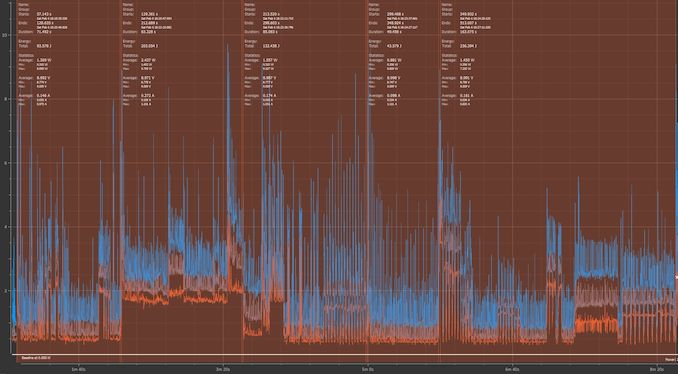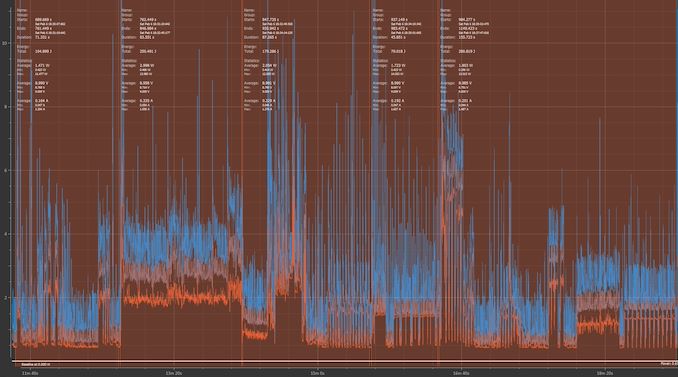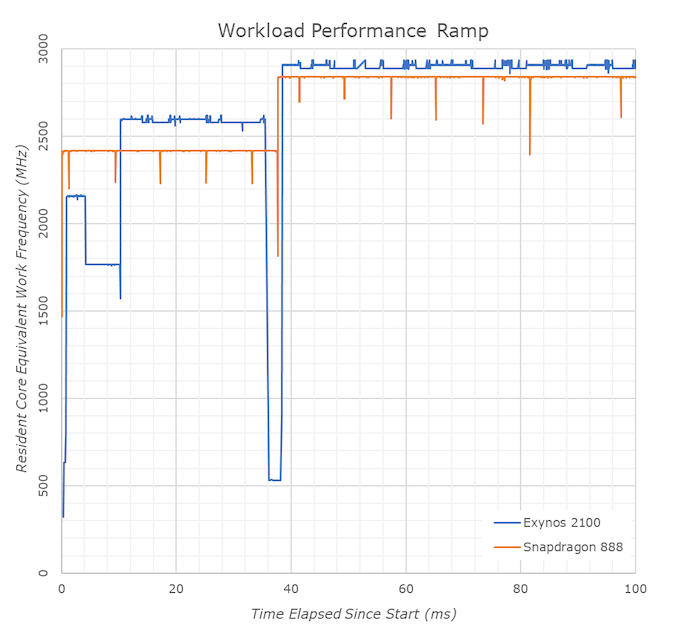The Snapdragon 888 vs The Exynos 2100: Cortex-X1 & 5nm - Who Does It Better?
by Andrei Frumusanu on February 8, 2021 3:00 AM EST- Posted in
- Mobile
- Samsung
- Qualcomm
- Smartphones
- SoCs
- Snapdragon 888
- Exynos 2100
Mixed-Usage Power & Preliminary Battery Life
We haven’t had both Galaxy S21 Ultra devices long enough to do our more extensive battery life testing routines, however I did run some more power analysis on the more compute-heavy PCMark suite as well as some battery life numbers at 120Hz.
I’ll start off with some power profiling – these figures are generally within 5% margin of error accurate in terms of power usage at the battery level but are measured as input power into device as this allows us much higher resolution data sampling, without actually dismantling the phones.
I put the devices to minimum brightness to minimise screen power attribution in the power figures, with the devices set to 120Hz mode and a lamp shining on them to enable the 120Hz VRR/LFD power savings on the display. Both devices are in their default performance modes.

Galaxy S21 Ultra - Snapdragon 888
The Snapdragon 888’s power chart looks relatively straightforward here, with the different sections corresponding to the different sub-tests in PCMark. We see a varied amount of activity with clear activity spikes and corresponding power spikes when the SoC had to do computations.
Instantaneous peak power is around the 9W mark, which should be mostly due to the Cortex-X1 cores of the chip running alongside the Cortex-A78 cores.

Galaxy S21 Ultra - Exynos 2100
The Exynos chart looks generally similar, which is no surprise given that it’s the same workload. What’s more interesting about the Exynos though is that it has much larger power spikes, up to 14W, which is notably more than the Snapdragon. The Cortex-A78 cores on the Exynos run much higher frequency and power than on the Snapdragon, and together with the higher power draw of the X1 cores, it makes sense that the Exynos’ instantaneous power is considerably higher when all the cores are under load.
The photo editing section of the test is very intriguing as the power profile is very different to that of the Snapdragon. This RenderScript section should be accelerated by the GPU, and here we see the Exynos’ baseline power goes up significantly compared to the Snapdragon for the majority of the test. This is almost 1W in magnitude – I really wonder what’s happening here under the hood and where that power comes from – maybe the GPU doesn’t have as fine-grained power gating or DVFS?
| Galaxy S21 Ultra Power Usage in PCMark Minimum Brightness, 120Hz, Default Performance Mode |
|||
| Snapdragon 888 Score - Power Usage |
Exynos 2100 Score - Power Usage |
% Difference Exynos vs Snapdragon |
|
| Idle Score Screen | 759mW | 797mW | +4.8% |
| Web-browsing | 12935 - 1309mW |
13159 - 1471mW |
+1.1% - +11.0% |
| Video Editing | 7866 - 2437mW |
6576 - 2998mW |
-16.4% - +18.7% |
| Writing 2.0 | 12966 - 1556mW |
15370 - 2054mW |
+18.5% - +24.2% |
| Photo Editing | 26884 - 881mW |
32385 - 1723mW |
+20.4% - +48.9% |
| Data Manipulation | 9918 - 1450mW |
8930 - 1803mW |
-10% - +19.6% |
Tabulating the PCMark test scores with the respective power figures across both Galaxy S21 Ultras, we see a few trends.
Performance wise, surprisingly enough, the Exynos has a few sub-tests where it outperforms the Snapdragon, notably in the Web-browsing, Writing and Photo editing tests. The Writing subtest particularly shows a +18% advantage in favour of the Exynos, while it loses more notably in the more single-threaded bound Data Manipulation test.
What’s also notable is that the Exynos’ power consumption is quite higher, across the board on all tests. The Photo Editing test aside where it has a 49% power disadvantage (which is actually high if we were to account for baseline device power), the rest of the test should be apples-to-apples CPU comparisons. We’re seeing roughly +15-20% device power disadvantages, and when account for baseline, this actually grows to around 18-35%. The Exynos does showcase a performance advantage in some of the tests, but not enough to make up for the increased power, meaning perf/W is lower.
Looking at the DVFS of the two chips, we see that they’re generally reaching peak performance at roughly the same time in around 37-38ms. The Snapdragon 888 will schedule a workload directly on the A78 cores at 2.41GHz during that time before ramping up to the X1 cores at 2.84GHz. The Exynos starts off on the A55 cores at idle frequencies around 400-624MHz for 900µs, ramping up to 2210MHz for 4.2ms, before migrating onto the Cortex-A78 cores which start at 1768MHz and ramp up to 2600MHz. Oddly enough, when migrating to the X1 cores the scheduler seems to have troubles migrating the load as the cores run at the idle 533MHz before realising they have work to do and ramp up to the maximum 2.91GHz.
What’s interesting about the Exynos here is that for single-threaded workloads it doesn’t actually visit the A78’s max frequencies – which is actually a benefit for power efficiency and makes the SoC behave more like the Snapdragon counterparts even though is has higher peak frequencies. What’s a bit concerning to see is that even in this extremely simplistic load which is just an add dependency chain, the X1 cores on the Exynos don’t look solid, but rather fluctuate quite a bit. The resulting 2888MHz readout actually doesn’t exist in the SoC’s frequency tables, so I have to wonder if that’s actually real, or if Samsung has employed some new sort of hardware DFS mechanism that works on extremely fine-grained timescales.

In terms of battery life in PCMark between the two phones, because we measured higher power draw on the Exynos, we naturally also see lower battery life on the new Samsung chip compared to the Snapdragon 888 variant of the S21 Ultra. The battery life here is tested in our traditional fashion, with the screen calibrated to 200cd/m² brightness.
The Snapdragon 888 S21 Ultra here fares better than the Galaxy S20 Ultra in terms of battery life, but by a quite minor amount. These results aren’t exactly great given the S21 Ultra’s massively more advanced and more efficient display.
For the Exynos 2100 S21 Ultra, the battery results here are actually slightly worse than the Exynos 990 S20 Ultra. This means that despite the new much more efficient screen, the Exynos 2100 is so aggressive in terms of performance scaling, that it draws notably more average power than the Exynos 990. Yes, the Exynos 2100 is also significantly more performant than its predecessor and this is immediately visible in terms of device usage, but it’s performance that wasn’t just achieved through efficiency, but also through more power usage.
We also got a smaller S21 with the Exynos 2100 – this variant as well as the S21+ do not have the new super-efficient OLED screen the S21 Ultra has, and as such the SoC’s more aggressive power draw is more prominently showcased through quite bad power efficiency in this test at 120Hz.

In the web-browsing test, which is less compute heavy and leans more towards display power consumption, both the new S21 Ultras fare significantly better than their predecessor due to the now much improved OLED display. These 120Hz numbers (at QHD no less), are actually fantastic, and just shows the new advancements of the new panel.
Nevertheless, the Snapdragon 888 variant of the S21 Ultra is still falling ahead of the Exynos 2100 version due to the better SoC efficiency and lower power levels. The 12.7% lead here is also similar to the general SoC efficiency differences we’ve seen in the other tests.
Update: February 14th - I'm retracting the 120Hz battery life results of the new VRR/LFD display devices pending re-testing, after discovering power-management inconsistencies in the test results. 60Hz results seem unaffected. Further details in the full review.
As we spend more times with the devices, we’ll be completing the test numbers at 60Hz as well as getting data from our web-browsing test. For the time being, the general view is that these new SoCs showcase quite increased performance, however their power draw has also gone up – meaning that battery life generationally should actually go down – with the exception of other non-SoC factors such as the S21 Ultra’s new more efficient display panel.











123 Comments
View All Comments
Andrei Frumusanu - Tuesday, February 9, 2021 - link
I don't have 5G coverage here so it's not feasible for me to test.Edwardmcardle - Wednesday, February 10, 2021 - link
Will you be testing reception differences e.g. 4g and wifi? Fantastic write up as always!Dorkaman - Tuesday, February 9, 2021 - link
Different s21 ultra phones can have different performance says tech chaphttps://youtu.be/yuNNmf2gIRc
I guess this is due to binning and his tests show his Exonys 2100 is in the middle. Strange. Also, the battery life is better on the 888 and external temps are about the samd.
serendip - Tuesday, February 9, 2021 - link
All this really doesn't look good for Windows on ARM if we're stuck with hot and hungry Qualcomm chips on Samsung 5nm. The 8cx and SQ on TSMC 7nm were very efficient but that's with slower A76 cores. I'm hoping a quad-X1 design on TSMC 5nm will be in the next iteration of the Surface Pro X or Galaxy Book S.Raqia - Tuesday, February 9, 2021 - link
Disappointing sustained performance, however the S21 series lacks the phase change vapor chamber cooling solution of the S20's:https://9to5google.com/2021/01/18/samsung-galaxy-s...
vs
https://www.ifixit.com/News/43501/why-samsung-buil...
Notably the Mi11 has this:
https://gadgettendency.com/a-triple-chamber-as-a-s...
This makes for better subsequent runs but the SoCs built on 5LPE are still disappointing.
iphonebestgamephone - Wednesday, February 10, 2021 - link
Mi 11 may have the vapor chamber for better cooling, but it also allows for a higher battery temperature. If they throttled at the same temps we could see how useful that thing actually is.dudedud - Wednesday, February 10, 2021 - link
Not all S20s had that vapor chamber. Some just had a graphene layer, which in theory would give similar results. Don't know if the S21 uses graphene tho.darkich - Wednesday, February 10, 2021 - link
The battery life benchmarks are indication of how actually invalid the whole Anantech's premise is.Pretty much ALL actual real usage tests have shown BIG improvements in the autonomy between the S20/S21 yet Andrei wants us to believe in the stupid benchmark test that shows "regression" between Exynos 990 and Exynos 2100.
What a joke..
ChrisGX - Sunday, February 14, 2021 - link
I would say these results are incomplete rather than invalid. The PCMark Work 2.0 - Battery Life test is a demanding mixed usage benchmark. When running that benchmark it isn't exactly a shock that the Exynos 2100 S21 Ultra should return very slightly reduced battery life than the Exynos 990 S20 Ultra. Anandtech isn't alone in noting that when processing demanding workloads the Exynos 2100 draws more power (on average) than the Exynos 990. Andrei, for his part, is explicit that the Exynos 2100 is also significantly more performant than its predecessor. He does say that the increased performance wasn’t just achieved through improved efficiency, but also through greater power usage and it is hard to dispute that looking at the numbers.There is a gap in the data however. The full PCMark Work 2.0 - Battery Life test involves a Work performance score that gives a more complete picture of how much work/the rate that work is being completed while executing the test. That would be very useful information to have. Still, it is undoubtedly the case that the reduction in battery life that Andrei mentions is not due to a regression but rather the increased rate that the Exynos 2100 is executing work (when processing demanding mixed usage workloads). While that information isn't provided in connection to the PCMark Work 2.0 - Battery Life test the GFXBench GPU heavy test data (arranged in Power Efficiency tables) does confirm the high power draw of the Exynos 2100 during peak performance bursts (which must bump up average power consumption as well) even as that chip roundly outperforms the Exynos 990.
Indeed, heavy mixed usage workloads are not going to put the Exynos 2100 battery life in the best light. Still, Andrei did show the results from a Web Browsing Battery Life test that undoubedly will be useful to a lot of phone users who don't view the results of the PCMark Work 2.0 - Battery Life test as having a lot of relevance for them. But, I, for one, am happy to have that information.
Andrei seems to be adding to/reworking the battery life data in this review.
https://benchmarks.ul.com/pcmark-android
https://s3.amazonaws.com/download-aws.futuremark.c...
sachouba - Wednesday, February 10, 2021 - link
Nice peak power consumption!It doesn't seem unlikely that we'll end up with a situation similar to Apple's battery gate on Snapdragon 888 devices, in a few years. Way to go!